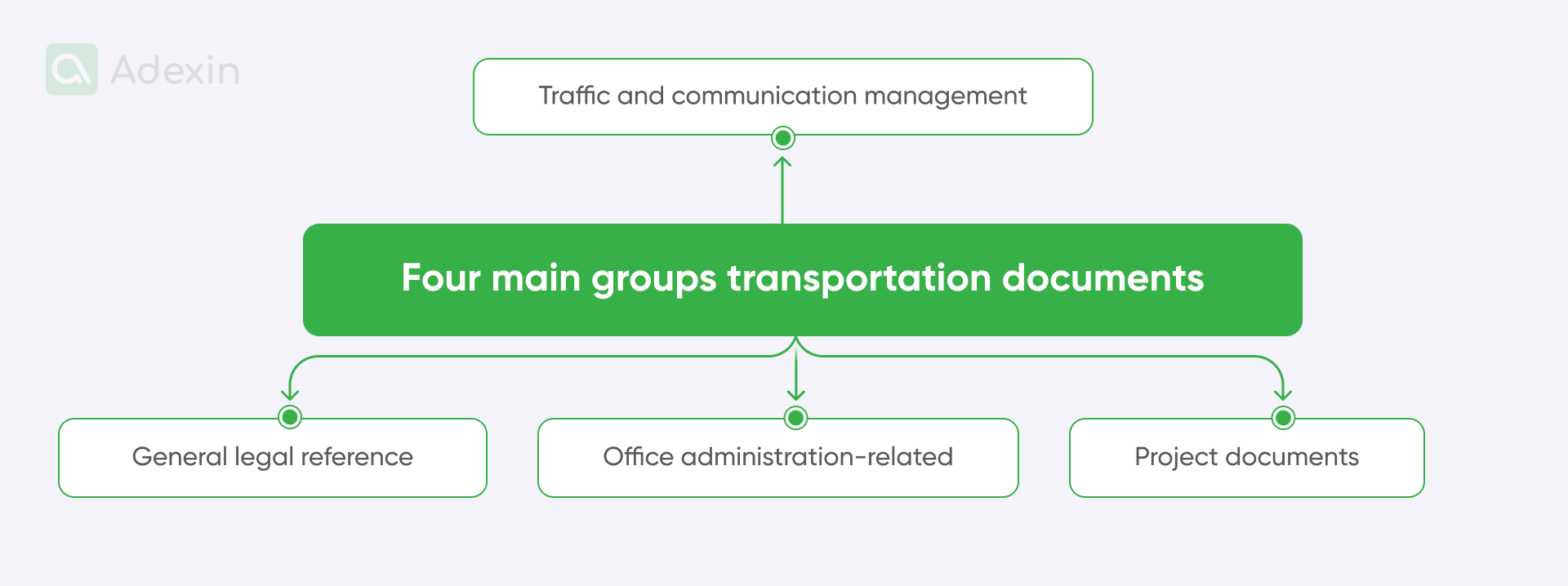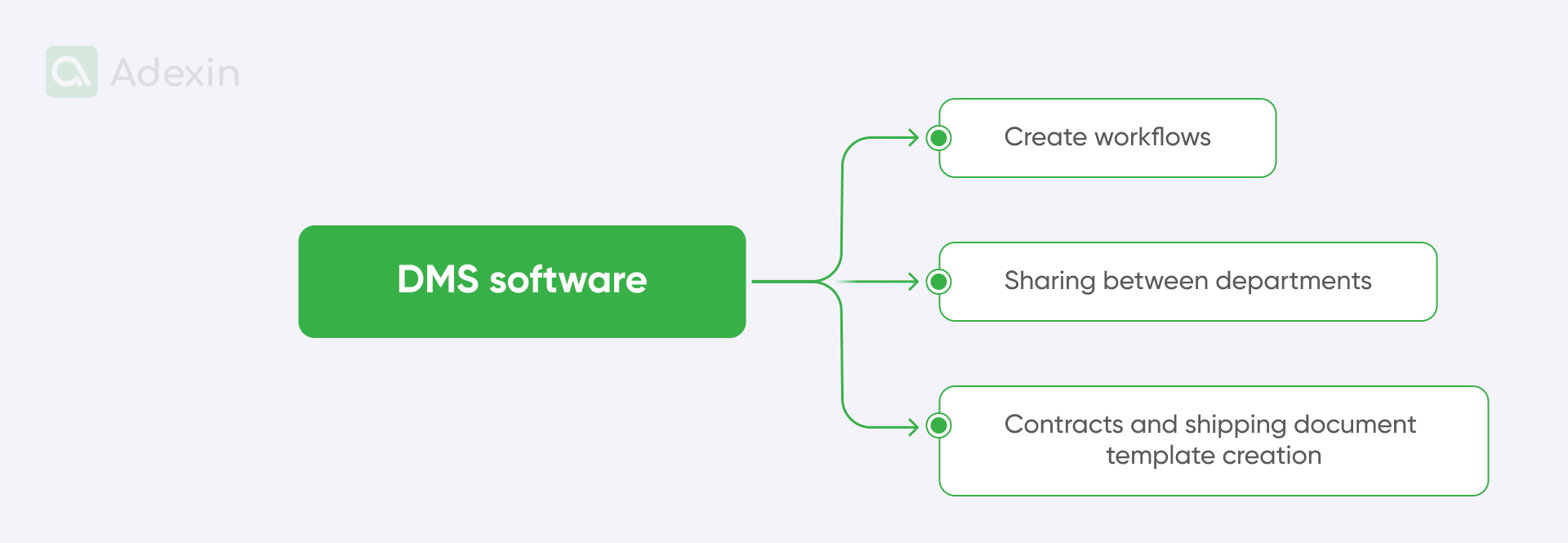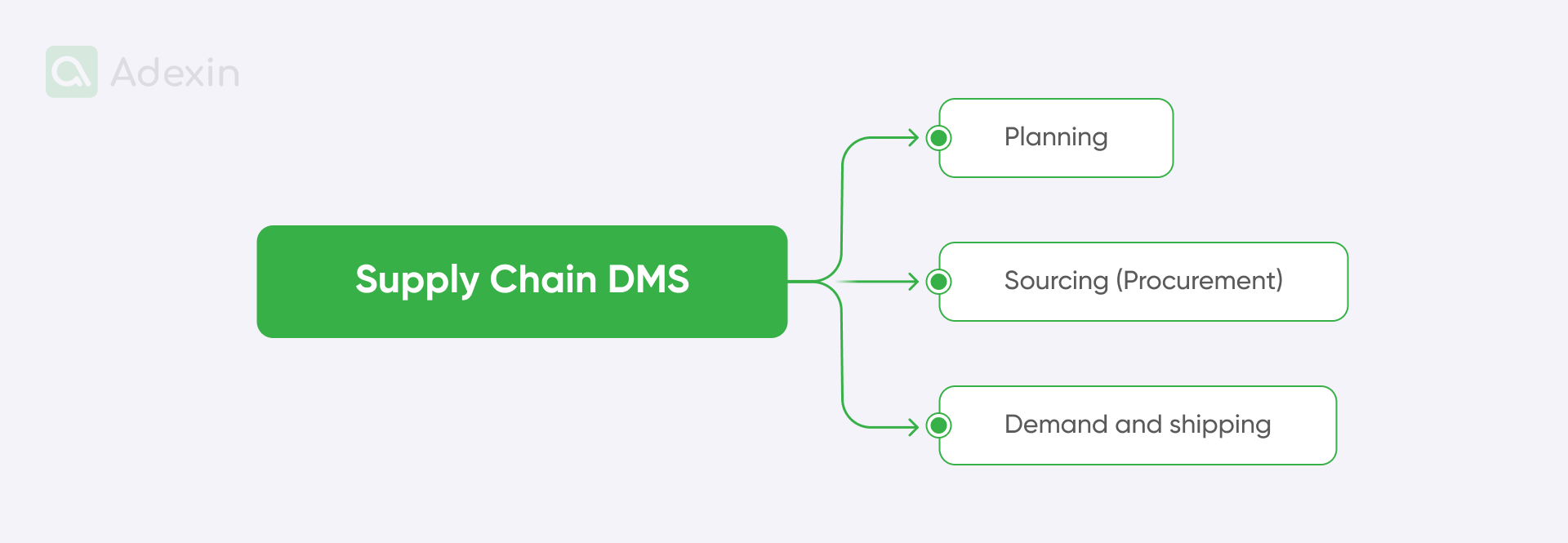Summary
This article highlights the importance of Document Management System (DMS) software and helps you understand how to overcome the limitations of document-related challenges within the transportation industry. Let's look at the transition to digital documentation and how to solve common problems such as manual filing, data entry errors, and data processing issues. We outline how DMS software for document management systems can solve these problems. We also list the benefits of DMS that can shed more light on streamlining workflows, improving collaboration, and ensuring document security. The DMS document software is presented as an essential tool to improve document management in the transportation industry. Let's see together how we can make it better.
What is DMS software used for?
The transportation industry is overwhelmed by the amount of printed documents. Document distribution and document flow are making work for everyone in transportation much more difficult due to many challenges. Companies struggle to manage workflow between business units in the best possible way. In the era of digital transformation, companies focus on transitioning to electronic documents.
Electronics, which are even better known as digital documents, are handled in modern ways using Document management (DM). Within this function software applications or platforms perform data management tasks suited to typical unstructured documents. This approach helps with complex document management and managing the flow of documents through their life cycles. [1]

There are four main groups of documents to be managed in transportation:
Traffic and communication management documents
Communication management documents deal with the transfer of information between the various stakeholders associated with the project in the entire supply chain ecosystem.
General legal reference documents
General reference documents, such as transport law regulations, pricing guides (mostly for fuel and sustainability policy coverage), request catalogs, and transportation procurement documents, are used in shaping and decision-making.
Office administration-related documents
Office management documents are related to the daily management of the office. The office often deals with more than one project at a time.
Project documents
Specific project documents are needed to organize, specify, and manage transportation project details. These may include forecasting, route planning, quarter reviews, scheduling, and reports. [2]
Transportation companies are keen to implement DMS software, which stands for Document Management Software, for best efficiency effects. It's all about managing digital documents assets across organizations.
Why is DMS software needed?
Transportation document management has traditionally focused on managing a small group of business-relevant documents that are most frequently used in the industry. It was handled in that way to keep costs as low as possible.
However, the document management market is steadily evolving into a two-tier market. This is creating a highly competitive environment in which new competitors in the transportation industry are increasing their ability to manage the hundreds of documents created during daily business life. They understand well the current DM business challenges. [1]
What are the challenges for document management?
Transport coordinators, admiring employees, and finally, truck drivers who are almost at the end of the document flow are the ones who need to deal with paperwork daily. Here are the challenges they're facing in their day-to-day activities:
Manual filling
Manual filing documents is a task that not many of us enjoy, but modern times don't make it easier for everyone. Many people in the transportation industry are still forced to physically file documents template formalizations, which are still necessary to hold communications between stakeholders and keep shipping records.
Errors
Mistakes can happen and cause problems. These are even worse when it comes to shipping quantity across the ocean. Other frequent errors come from incorrect invoices based on data entry errors.
Difficult archiving
Transportation companies must handle contracts, shipping documents, reports, etc. Everything can need to be stored and managed, but having this in paper printed copy doesn't save time and requires tremendous office space.
Poor data protection
Taking care of data protection policy is vital for any business, including transportation. A data breach due to uncontrolled shipping document flow can be costly regarding finances, security, and reputation.
Lack of mobility
No access from mobile devices to documents makes life much more difficult, especially for truck chauffeurs who are forced to handle paper documents while also needing to unload the trailer by themself.
Document loss
Due to manual handling, documents are often lost, and along with lost documents come compliance and delays in delivery.
Paperwork remains a major cause of data breaches and frustration for anyone who has to deal with it in the cycle. People cannot read documents due to poor writing or character recognition. Someone can gain insight into confidential documents without permission. There are always some other problems, but they can be solved by DMS software.
How to use DMS software?
To ensure compliance with data regulations, protect my business, maintain data quality, and provide it on time to prevent late deliveries – these are some of the main goals of every transport manager regarding document management. Of course, documents must be regularly shared and disposed of among the right people and need to be handled securely. This feature can be provided by document and workflow management within custom software development.

To provide solutions for associated business goals, DMS software should enable users with certain capabilities. These affect the way DMS software is used by all employees:
Create workflows
Transportation administrators can create digital workflows that validate document access for individual users. In this case, administrators can easily track document progress and manage contracts and agreements with carriers and other freight forwarders.
Sharing between departments
With DMS software, you can access any type of transportation document you want at any time. It doesn't matter whether you use mobile or desktop devices. You can see all the necessary details regarding shipping confirmations to make sure the documents delivered match the purchase order number and other details.
Contracts and shipping document template creation
Users of DMS software can create various document templates and shipping forms. The documents can be freely modified as soon as legal requirements are changed. Often, there is a section of the document that requires specific information from the carrier or shipper. This can be easily modified digitally, like service agreements and contracts.
What is a DMS in supply chain?
The transportation sector has its own specific characteristics when it comes to Document Management Systems (DMS). In the supply chain context, transportation plays a crucial role by connecting stakeholders and ensuring that the necessary documents are always in place.

Here are the key parts of the supply chain where managing transportation documents through DMS is of utmost importance:
Planning
Transport planning requires developing strategies and forecasting that are based on the reports. Shipping planning is a very frequent operation in supply chain transportation that also requires updated documents and swift data exchange. To let the processes go smoothly, all documents are supposed to be digitized and stored in DMS.
Sourcing (Procurement)
Anytime warehouse operations are required to contract a new carrier, they need to dive into procurement to choose the best possible freight forwarded for their operations. DMS helps manage this process, keeping digitized documents secured along with other outsourcing contracts and agreements.
Demand and shipping
In the field of supply chain, customer demand is constantly changing, and these changes affect transportation, which must efficiently forecast and manage inventories to meet customer needs without excess. Along with this, companies require a fast document management system to properly adjust documents and exchange them with all service providers.
How does digital documentation help manage DMS?
A Document Management System (DMS) is perceived by the transportation industry as an absolute must-have, especially in constantly growing business structures or whenever there is a significant flow of documents. DMS software uses digital formats to help manage the entire document flow more effectively.
Support for fast collaboration
Digital documents enable the use of DMS collaboration tools such as workflows, co-authoring, charts, and messages. Do you need these features?
Easy-to-use
Digital documents are easy for employees to use. They have high user adoption, so make sure the DMS minimizes employee frustration with an intuitive and user-friendly interface built into the software.
Customer support
Accessing documents is easier when they are digitized. Customers can get support faster because the mechanism to request documents is simplified.
Training
In a digital format, users can be trained much faster. With digitised documents, anyone can get on-site training or access webinar videos and documentation with just a few clicks.
Security
Digitized documents are easier to protect. DMS can use security protocols built into the software. Transport administrators can restrict access to specific folders and individual employees.
Document digital DMS – advantages and disadvantages
DMS software is very useful, but it's always important for transportation to assess every pain point in the business to avoid missing anything that can cause problems in our operations later on. Here are the advantages and disadvantages of DMS software:
Advantages | Disadvantages |
|---|---|
What are the best DMS software features?
Digital document management systems commonly provide storage (servers or Cloud-based solution), structured architecture for management, metadata, security, as well as indexing and retrieval capabilities. Here you can read more about DMS software features:
Smart organization
Intelligent organization of functions helps efficiently categorize and structure documents, making them easier to find and manage, ultimately improving workflow and productivity.
Smart interface
A user-friendly and intuitive interface simplifies document navigation and retrieval, reducing the learning curve for employees and improving the overall user experience. It also helps to maintain error-less documentation.
Search function
The robust search function allows documents to be searched quickly and accurately, saving time and improving efficiency by finding relevant documents faster.
Version control
Version control ensures that the latest document versions are available and easily identifiable, preventing errors and confusion caused by outdated information.
Access protection
Protection is absolutely fundamental. Rights determine who can access, edit, and share documents. This helps you protect sensitive information and maintain data integrity.
Different file format support
Support for different document formats ensures consistency and flexibility, enabling at the same time the system to handle different types of files and media seamlessly.
Management architecture
An easy-to-understand and logical system architecture makes it easy for users to navigate the system. It eliminates confusion and reduces management problems.
Integration
DMS can seamlessly connect with other transportation systems for data flow. The Transport Management System (TMS) requires various shipping document management.
These features contribute to a comprehensive and effective document management system that can meet the specific needs of a company.
Along with features come much stronger benefits that DMS delivers to the organization:
Error less
DMS software automates the process of document exchange and data processing, reduces errors, and ensures compliance with company guidelines, which is especially crucial for accounting and compliance departments.
Increased productivity
DMS software enables digital document management, which typically increases productivity and speeds up document processing.
Better data protection
Digital document management systems ensure compliance with data protection regulations.
Higher management visibility
Enabling leaders to have a clear view of their organization's activities and let them make informed decisions.
Mobile and user-friendly
Digital documents are easily accessible from mobile devices, creating an environment that supports working remotely or on the go with the right tools and flexibility.
Quick customer approval
End-customers and intermediaries in the supply chain can easily confirm documents from their side. DMS software meets or exceeds customer expectations to ensure satisfaction and loyalty, as a customer can track all the shipping/delivery processes.
Let's summarize quickly
You may ask yourself what you're looking for when you want to start with professional document management in your organization. The fact of the matter is that some open-source tools don't provide the required capabilities to your business to offer you the right DMS functionality. There will most likely be something missing that will make day-to-day operations more and more difficult to run.
The best choice for small or medium-sized companies is to begin with customized DMS development. This approach can help businesses scale over time with low costs, as DMS software can have built-in capabilities that allow for enhanced document management functionalities. Therefore, such a solution is also highly suitable for larger transportation companies, offering a relatively fast perspective on return on investment (ROI).
At Adexin, we've been helping companies grow for more than 10 years. We have satisfied customers from the transportation industry because we understand that business. Contact us today and see what we can do together to improve your document management. Let's see how DMS software can improve your transportation document management.
References:
[1] Retrieved from: https://www.gartner.com/en/information-technology/glossary/document-management-dm
[2] Retrieved from: https://dbc.wroc.pl/Content/119842/Wojtowicz_Introduction_to%20electronic_documeny_management.pdf
